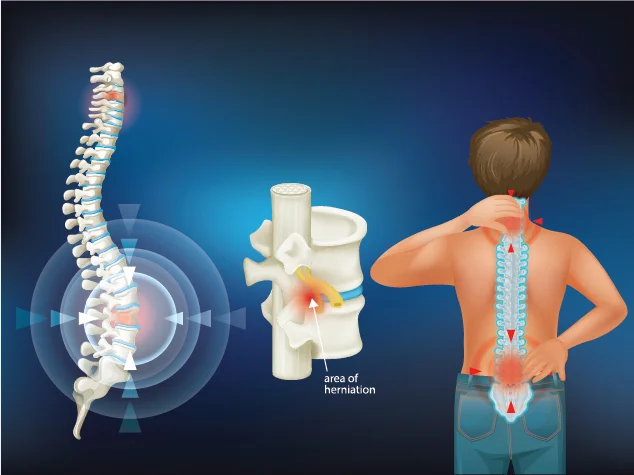Spinal cord disorders refer to any condition or injury that affects the spinal cord, which plays a crucial role in transmitting signals between the brain and the rest of the body. Damage or disease affecting the spinal cord can lead to significant impairments in sensation, movement, and autonomic functions like breathing, digestion, and bladder control. These disorders can result from trauma, infections, tumors, degenerative diseases, and other factors.
Common spinal cord disorders include:
- Spinal cord injury (SCI): Damage to the spinal cord from trauma (e.g., accidents, falls).
- Multiple sclerosis (MS): An autoimmune disorder that damages the spinal cord’s myelin sheath.
- Spinal cord tumors: Abnormal growths (benign or malignant) in or around the spinal cord.
- Spinal stenosis: Narrowing of the spinal canal that compresses the spinal cord or nerves.
- Infections: Conditions like meningitis or spinal cord abscesses.
- Syringomyelia: A cyst or cavity forms within the spinal cord, causing damage over time.
Symptoms:
Symptoms of spinal cord disorders vary depending on the location and extent of the damage. They may include:
- Pain: Localized or radiating pain in the neck, back, or extremities.
- Weakness or paralysis: Partial or complete loss of muscle function, potentially affecting the arms, legs, or both (quadriplegia or paraplegia).
- Loss of sensation: Numbness, tingling, or loss of feeling, especially in the hands or feet.
- Coordination issues: Difficulty with balance, walking, or fine motor skills.
- Loss of bladder or bowel control: Urinary incontinence or constipation.
- Autonomic dysfunction: Problems with heart rate, blood pressure, or breathing.
Causes:
- Trauma: Car accidents, falls, sports injuries, or violent acts can cause fractures, dislocations, or compressions in the spine, leading to spinal cord injury.
- Degenerative conditions: Diseases like osteoarthritis and degenerative disc disease can cause narrowing of the spinal canal (spinal stenosis), resulting in compression of the spinal cord.
- Infections: Conditions like viral, bacterial, or fungal infections can affect the spinal cord directly or lead to inflammation of surrounding tissues (e.g., abscesses).
- Tumors: Primary or metastatic cancer can affect the spinal cord and nerves.
- Autoimmune diseases: Conditions like multiple sclerosis cause immune-mediated damage to the myelin sheath of spinal cord neurons.
- Congenital disorders: Conditions like spina bifida, where the spinal cord doesn’t develop properly during fetal growth.
Treatment:
Treatment varies depending on the type, severity, and cause of the disorder:
- Medications:
- Steroids: Reduce inflammation and swelling in acute injuries or conditions like multiple sclerosis.
- Pain relievers: To manage pain symptoms.
- Muscle relaxants: Help reduce muscle spasms.
- Immunosuppressants: Used in conditions like multiple sclerosis to reduce immune system activity.
- Surgery:
- Decompression surgery: Relieves pressure on the spinal cord (e.g., spinal stenosis).
- Tumor removal: To remove or reduce the size of spinal cord tumors.
- Spinal fusion: Stabilizes the spine after fractures or degeneration.
- Physical and Occupational Therapy:
- Rehabilitation to regain or maintain function, improve mobility, and prevent complications such as muscle atrophy or joint stiffness.
- Assistive Devices:
- Braces, walkers, or wheelchairs: Help with mobility and stability.
- Stem Cell Therapy & Experimental Treatments:
- Some new therapies are under investigation, especially for spinal cord injuries, such as stem cell therapy to promote regeneration.
Prevention:
Preventing spinal cord disorders focuses on reducing risk factors and maintaining a healthy spine:
- Prevent falls and accidents: Wear protective gear during sports, practice safe driving, and take fall-prevention measures for the elderly.
- Exercise: Maintain strength and flexibility, especially in the back and core muscles, to support spinal health.
- Proper posture: Avoid straining the spine with poor posture during sitting, standing, or lifting heavy objects.
- Routine check-ups: Early diagnosis and treatment of infections, autoimmune diseases, or cancer can help prevent serious complications.
- Vaccination: Prevent infections that can affect the spinal cord, like meningitis.
In summary, spinal cord disorders range from traumatic injuries to diseases affecting spinal health. Early diagnosis, treatment, and preventive measures are key to reducing long-term complications and improving quality of life.
































